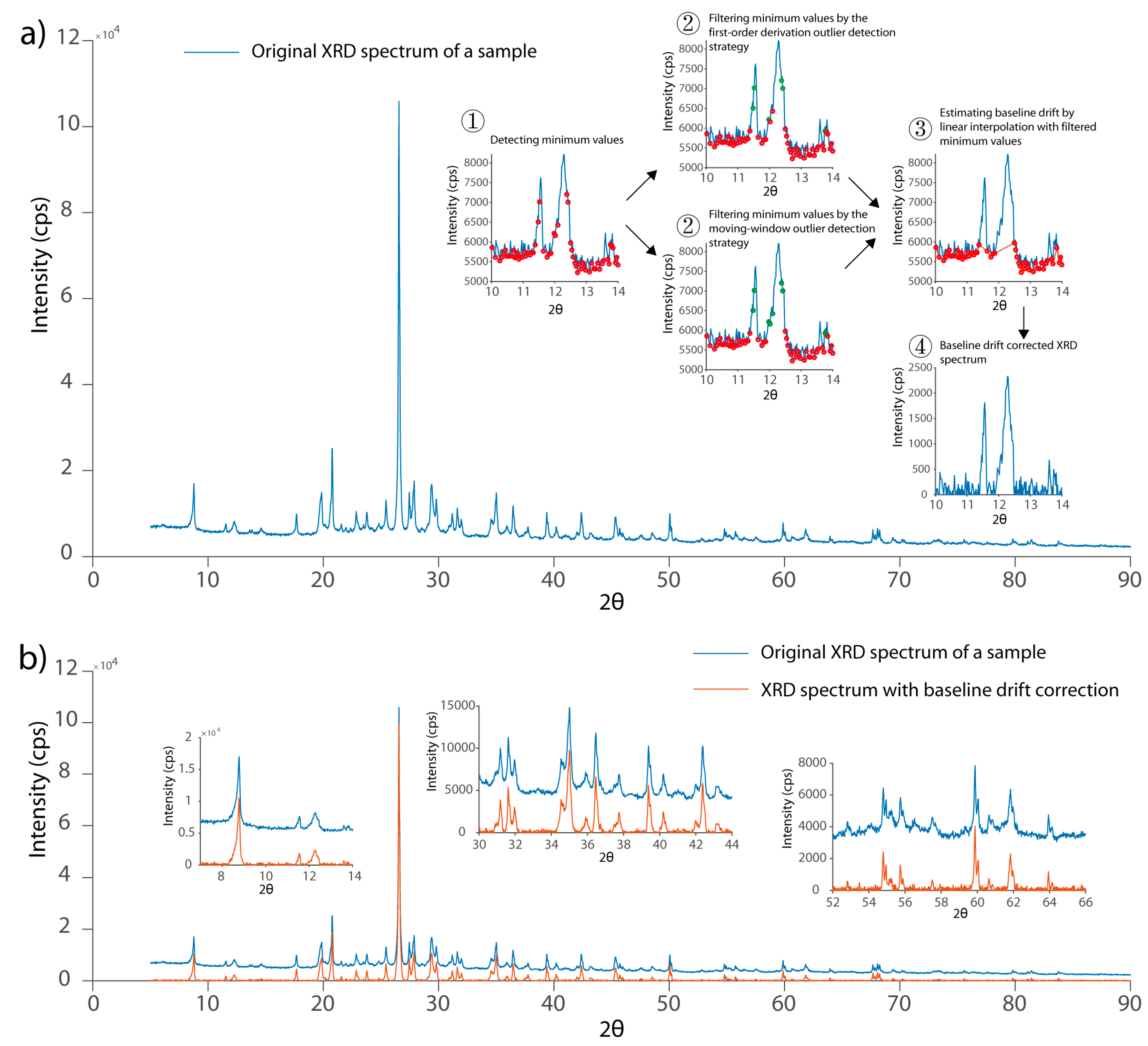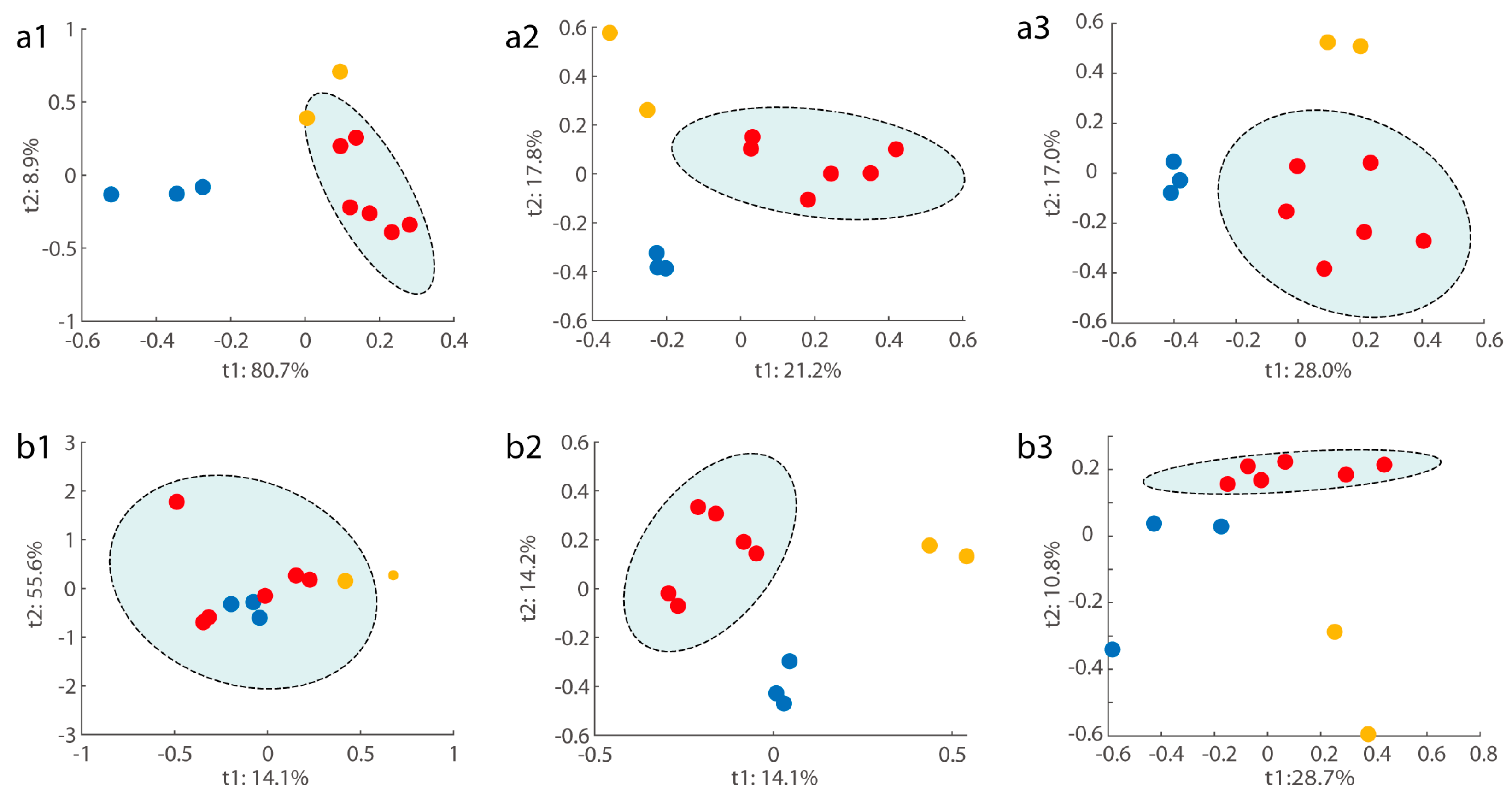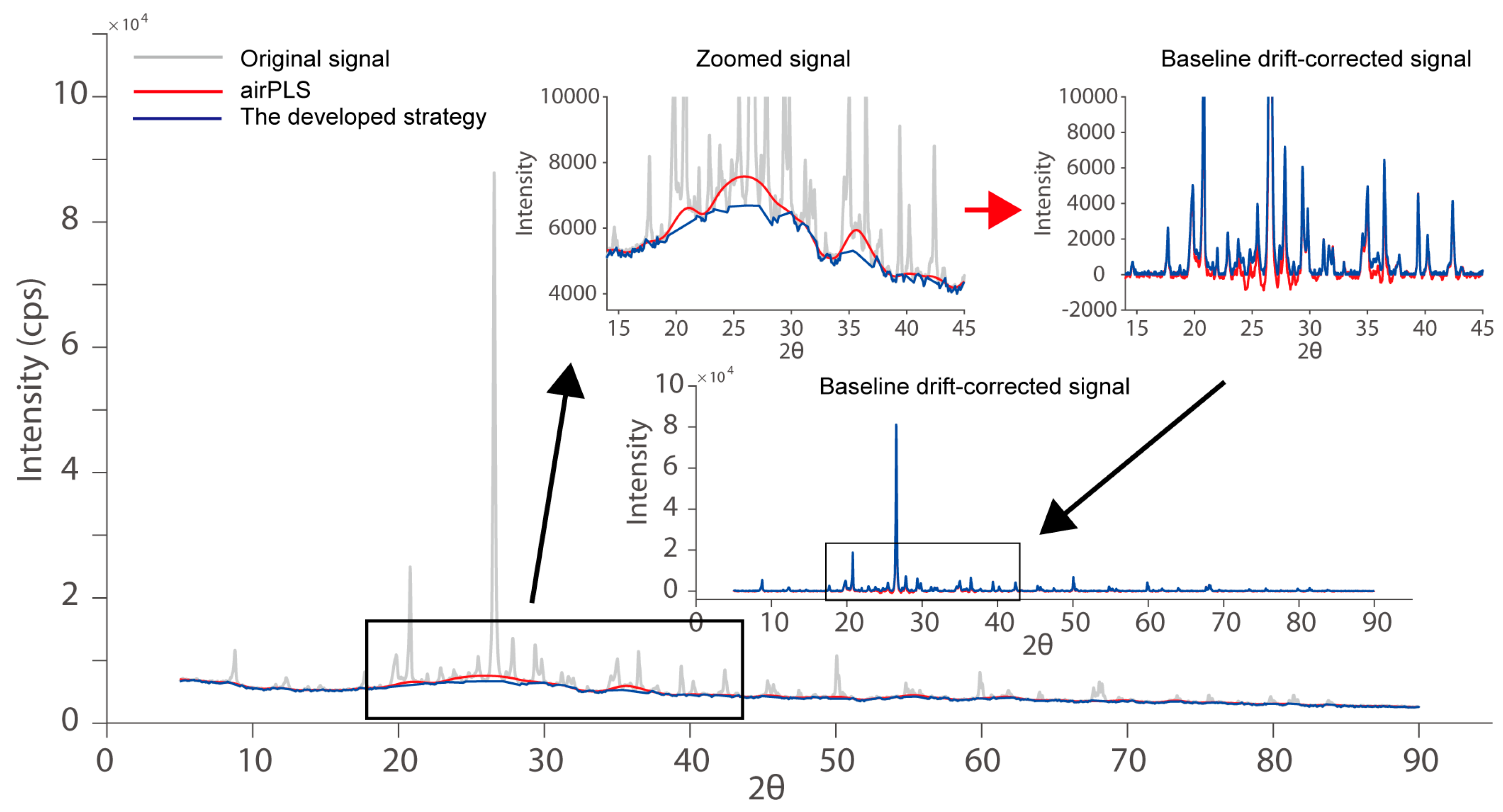A New X-ray Diffraction Spectrum-Based Untargeted Strategy for Accurately Identifying Ancient Painted Pottery from Various Dynasties and Locations in China
Abstract
1. Introduction
2. Experiment and Methodology
2.1. Experiment
2.1.1. Painted Pottery Collection
2.1.2. XRD Analysis
2.1.3. EDS analysis
2.2. Methodology
2.2.1. Local Minimum Detection
2.2.2. Outlier Detection
- (i)
- The first-order derivation vector d was calculated based on the original local minimum vector vorg;
- (ii)
- The robust statistical standard derivation was estimated according to Equation (4);
- (iii)
- The outliers whose first-order derivation values exceed 3 * ε were identified and replaced with a linear interpolation strategy to obtain a new vector vnew;
- (iv)
- vorg was replaced with vnew, and sub-steps (i) to (iii) were repeated until no outliers remained.
- (i)
- For each element in the original local minimum vector vorg, its signal-to-noise ratio was calculated according to Equation (5).
- (ii)
- The outliers whose signal-to-noise ratios exceeded 3 were identified and replaced through linear interpolation to obtain a new vector vnew.
- (iii)
- vorg was replaced with vnew, and sub-steps (i) to (iii) were repeated until convergence. The criterion of convergence was set as , where represents the Frobenius norm.
2.2.3. Estimation for Baseline Drift
2.3. Chemometric Analysis
3. Results and Discussion
3.1. Investigation of Initialized Parameters on the Quality of Baseline Drift Correction
3.2. Performance in Addressing Various Kinds of Baseline Drift in the XRD Spectrum
3.3. Chemometric Analysis of Ancient Painted Pottery
3.4. Brief Comparison with State-of-the-Art Methods
4. Conclusions
Supplementary Materials
Author Contributions
Funding
Data Availability Statement
Conflicts of Interest
References
- Shalvi, G.; Shoval, S.; Bar, S.; Gilboa, A. Pigments on Late Bronze Age painted Canaanite pottery at Tel Esur: New insights into Canaanite–Cypriot technological interaction. J. Archaeol. Sci. 2020, 30, 102212. [Google Scholar] [CrossRef]
- Jones, R. The Decoration and Firing of Ancient Greek Pottery: A Review of Recent Investigations. Adv. Archaeomater. 2021, 2, 67–127. [Google Scholar] [CrossRef]
- Buravlev, I.Y.; Gelman, E.I.; Lapo, E.G.; Pimenov, V.A.; Martynenko, A.V. Three-colored Sancai glazed ceramics excavated from Bohai sites in Primorye (Russia). J. Archaeol. Sci. Rep. 2022, 41, 103346. [Google Scholar] [CrossRef]
- Gajić-Kvaščev, M.; Bikić, V.; Wright, V.J.; Radosavljević Evans, I.; Damjanović-Vasilić, L. Archaeometric study of 17th/18th century painted pottery from the Belgrade Fortress. J. Cult. Herit. 2018, 32, 9–21. [Google Scholar] [CrossRef]
- Li, Y.; Wu, S.; Yang, J. Multi-analytical investigation of decorative coatings on Neolithic Yangshao pottery from Ningxia, China (4000–3000 BCE). J. Eur. Ceram. Soc. 2021, 41, 6744–6755. [Google Scholar] [CrossRef]
- Wu, X.; Ji, F.; Zhang, X.; Wang, F.; Feng, F.; Lu, Q.; Zhao, S.; Zhang, Y.; Wang, C.; Huang, F.; et al. Geochemical evidence reveals a long-distance trade of white pottery in Neolithic China 5000 years ago. J. Archaeol. Sci.-Rep. 2022, 44, 103533. [Google Scholar]
- Ortega, L.A.; Zuluaga, M.C.; Alonso-Olazabal, A.; Murelaga, X.; Alday, A. Petrographic and geochemical evidence for long-standing supply of raw materials in neolithic pottery (mendandia site, spain). Archaeometry 2010, 52, 987–1001. [Google Scholar] [CrossRef]
- Bayazit, M.; Adsan, M.; Genç, E. Application of spectroscopic, microscopic and thermal techniques in archaeometric investigation of painted pottery from Kuriki (Turkey). Ceram. Int. 2020, 46, 3695–3707. [Google Scholar] [CrossRef]
- Bruni, S.; Guglielmi, V.; Della Foglia, E.; Castoldi, M.; Bagnasco Gianni, G. A non-destructive spectroscopic study of the decoration of archaeological pottery: From matt-painted bichrome ceramic sherds (southern Italy, VIII–VII B.C.) to an intact Etruscan cinerary urn. Spectrochim. Acta A 2018, 191, 88–97. [Google Scholar] [CrossRef]
- Copley, M.S.; Bland, H.A.; Rose, P.; Horton, M.; Evershed, R.P. Gas chromatographic, mass spectrometric and stable carbon isotopic investigations of organic residues of plant oils and animal fats employed as illuminants in archaeological lamps from Egypt. Analyst 2005, 130, 860–871. [Google Scholar] [CrossRef]
- Ichikawa, S.; Matsumoto, T.; Nakamura, T. X-ray fluorescence determination using glass bead samples and synthetic calibration standards for reliable routine analyses of ancient pottery. Anal. Chem. 2016, 8, 4452–4465. [Google Scholar] [CrossRef]
- Szalóki, I.; Braun, M.; Van Grieken, R. Quantitative characterisation of the leaching of lead and other elements from glazed surfaces of historical ceramics. J. Anal. At. Spectrom. 2000, 15, 843–850. [Google Scholar] [CrossRef]
- Weiss, C.; Köster, M.; Japp, S. Preliminary Characterization of Pottery by Cathodoluminescence and SEM–EDX Analyses: An Example from the Yeha Region (Ethiopia). Archaeometry 2016, 58, 239–254. [Google Scholar] [CrossRef]
- Aoyama, H.; Yamagiwa, K.; Fujimoto, S.; Izumi, J.; Ganeko, S.; Kameshima, S. Non-destructive elemental analysis of prehistoric potsherds in the southern Ryukyu Islands, Japan: Consideration of the pottery surface processing technique in the boundary region between the Japanese Jōmon and Neolithic Taiwan. J. Archaeol. Sci. Rep. 2020, 33, 102512. [Google Scholar] [CrossRef]
- Liu, Y.; Yang, F.; Wang, L. Exploratory research about the selective cleaning of calcium sulfate sediments on archaeological potteries. New J. Chem. 2020, 44, 7412–7416. [Google Scholar] [CrossRef]
- Rončević, S.; Svedružić, L.P.; Štrukil, Z.S.; Čakširan, I.M. Determination of chemical composition of pottery from antic Siscia by ICP-AES after enhanced pressure microwave digestion. Anal. Chem. 2012, 4, 2506–2514. [Google Scholar] [CrossRef]
- Hunt, A.M. The Oxford Handbook of Archaeological Ceramic Analysis; Oxford University Press: Oxford, UK, 2017. [Google Scholar]
- Heimann, R.B.; Maggetti, M. Ancient and Historical Ceramics; Schweizerbart Science Publishers: Stuttgart, Germany, 2014. [Google Scholar]
- Gliozzo, E. Ceramic technology. How to reconstruct the firing process. Archaeol. Anthropol. Sci. 2020, 12, 260. [Google Scholar] [CrossRef]
- Zhang, Q.; Li, H.; Xiao, H.; Zhang, J.; Li, X.; Yang, R. An improved PD-AsLS method for baseline estimation in EDXRF analysis. Anal. Chem. 2021, 13, 2037–2043. [Google Scholar] [CrossRef]
- Fu, H.Y.; Li, H.D.; Yu, Y.J.; Wang, B.; Lu, P.; Cui, H.P.; Liu, P.P.; She, Y.B. Simple automatic strategy for background drift correction in chromatographic data analysis. J. Chromatogr. A 2016, 1449, 89–99. [Google Scholar] [CrossRef]
- Baek, S.-J.; Park, A.; Ahn, Y.-J.; Choo, J. Baseline correction using asymmetrically reweighted penalized least squares smoothing. Analyst 2015, 140, 250–257. [Google Scholar] [CrossRef]
- Zhang, Z.-M.; Chen, S.; Liang, Y.-Z. Baseline correction using adaptive iteratively reweighted penalized least squares. Analyst 2010, 135, 1138–1146. [Google Scholar] [CrossRef] [PubMed]






Disclaimer/Publisher’s Note: The statements, opinions and data contained in all publications are solely those of the individual author(s) and contributor(s) and not of MDPI and/or the editor(s). MDPI and/or the editor(s) disclaim responsibility for any injury to people or property resulting from any ideas, methods, instructions or products referred to in the content. |
© 2024 by the authors. Licensee MDPI, Basel, Switzerland. This article is an open access article distributed under the terms and conditions of the Creative Commons Attribution (CC BY) license (https://creativecommons.org/licenses/by/4.0/).
Share and Cite
Song, J.-J.; Wang, Y.-Y.; Tong, W.-C.; Ma, F.-L.; Wang, J.-N.; Yu, Y.-J. A New X-ray Diffraction Spectrum-Based Untargeted Strategy for Accurately Identifying Ancient Painted Pottery from Various Dynasties and Locations in China. Chemosensors 2024, 12, 64. https://doi.org/10.3390/chemosensors12040064
Song J-J, Wang Y-Y, Tong W-C, Ma F-L, Wang J-N, Yu Y-J. A New X-ray Diffraction Spectrum-Based Untargeted Strategy for Accurately Identifying Ancient Painted Pottery from Various Dynasties and Locations in China. Chemosensors. 2024; 12(4):64. https://doi.org/10.3390/chemosensors12040064
Chicago/Turabian StyleSong, Jing-Jing, Yang-Yang Wang, Wen-Cheng Tong, Feng-Lian Ma, Jia-Nan Wang, and Yong-Jie Yu. 2024. "A New X-ray Diffraction Spectrum-Based Untargeted Strategy for Accurately Identifying Ancient Painted Pottery from Various Dynasties and Locations in China" Chemosensors 12, no. 4: 64. https://doi.org/10.3390/chemosensors12040064
APA StyleSong, J.-J., Wang, Y.-Y., Tong, W.-C., Ma, F.-L., Wang, J.-N., & Yu, Y.-J. (2024). A New X-ray Diffraction Spectrum-Based Untargeted Strategy for Accurately Identifying Ancient Painted Pottery from Various Dynasties and Locations in China. Chemosensors, 12(4), 64. https://doi.org/10.3390/chemosensors12040064



